May is usually a quiet time for flowers, but this year, there are many surprises to be found.
A special delight for me has been seeing flowers on Dwarf Boronia Boronia nana var. nana. This uncommon, low growing plant is distinguished by its four, pointed, waxy white to pink petals, and bright pink buds.
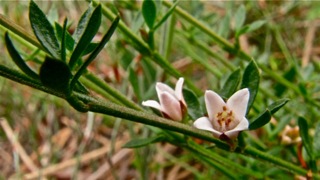
Dwarf Boronia
Other unusual sightings have included the lovely yellow flowers of our three main Guinea-flowers Hibbertia riparia, H. sericea and H. fasciculata.
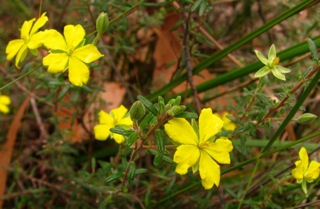
Erect Guinea-flower Hibbertia riparia
Cranberry Heath Astroloma humifusum, a mat-like plant, has been flowering profusely for some time, with its delightful, bright-red, tubular flowers really standing out among the bluish-green, fine pointed foliage.
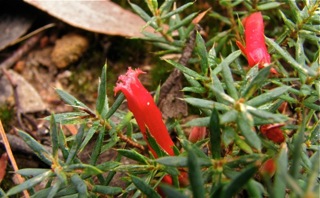
Cranberry Heath
Walking along the cliff tops, I have enjoyed seeing two, widespread shrubs in flower. Coast Everlasting Ozothamnus turbinatus is noticeable with its rich green, stiff, narrow leaves, and erect clusters of creamy-yellow, conical flowers, which have been attracting masses of colourful moths.
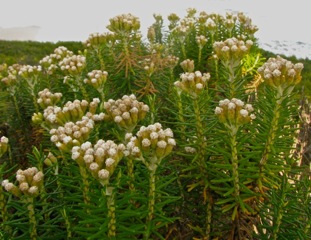
Coast Everlasting
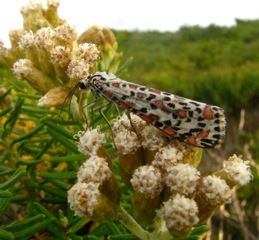
Coast Everlasting and Heliotrope Moth
White Correa C. alba var. alba is, unexpectedly, still displaying its white, spreading, four-petalled flowers.
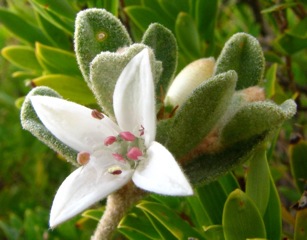
White Correa
In the heathlands and woodlands, Prickly Broom-heath Monotoca scoparia, an iconic plant for this time of year, is starting to blossom profusely, with its small cream flowers. If you look carefully with a magnifier, you may distinguish whether it is a male or female plant. The male has several, visible, brownish stamens, and the female, one, pale green ovary with stigma, but be careful of the foliage – it is aptly named.

Prickly Broom-heath – male
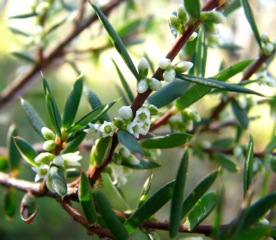
Prickly Broom-heath – female
Common Reed Phragmites australis, a tall, bamboo-like perennial, has been flowering profusely along the edges of rivers and swamps, with lovely, fluffy, plume-like seed-heads, which are purplish to white. This plant is found all over Victoria and is called Tark-korn by the local Wathaurong people, who ate the roots, which taste rather like bamboo shoots. The stems were used as spear shafts, and for making bags, baskets and necklaces.

Common Reed
May is a good time of year to look for seedpods, and two Acacias are especially interesting. Blackwood Acacia melanoxylon has long brown pods, which are twisted into strange shapes, with an occasional pale orange seed, which has a black centre, still lingering within the seedpods.
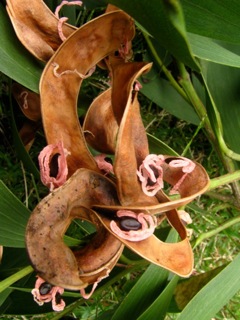
Blackwood seedpods
I have just discovered the seedpods of Hedge Wattle Acacia paradoxa. The outsides of the curved pods are unexpectedly thick, with soft white hairs, which contrast with the very sharp spikes along the stems and the rich green foliage.
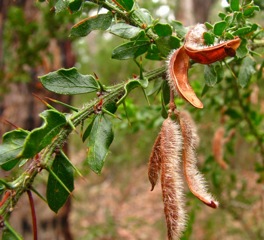
Hedge Wattle
So finally, the ‘smelly’ plant of the month has to be the appropriately named Sweet Wattle Acacia sauveolens. This widely spread plant heralds wattle time in our district. It stands out in the heathy woodlands because of its long, narrow, widely-spaced foliage, and its clustered, fluffy, globular, cream flowers, which are just starting to emerge from buds at the base of the phylodes.
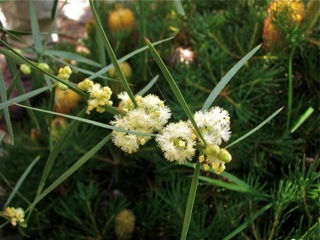
Sweet Wattle
You never know what may be on display, so remember to carry the Flowers of Anglesea and Aireys Inlet to help with your identification of plants.
Ellinor Campbell